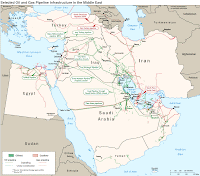On Friday, 23 March 2012, President Obama stated that tension with Iran was adding $20-$30 to oil prices:
"The key thing that is driving higher gas prices is actually the world's oil markets and uncertainty about what's going on in Iran and the Middle East, and that's adding a $20 or $30 premium to oil prices," Obama said in an interview with the American Automobile Association (AAA) published Friday.

So just how much tension is the world pricing in to each barrel of oil?
One way to find out is to estimate how much the world's oil supplies might be disrupted if tensions escalate. To do that, we've re-engineered the math from one of our recent tools so that we can find out how much oil would need to be either added or removed from world production in order to change the price of a barrel of oil by the amount that President Obama, or you, might enter.
Most of the other oil-related default data in the tool applies to the most recent figures we have from the U.S. Central Intelligence Agency, which at this writing, applies to 2010, and which we'll assume is similar to today's production figures. If you have more current data, enter it (the same applies for the values of the supply and demand elasticities for oil....)
Since the tensions to which President Obama refers would primarily affect the supply of oil originating from Iran and the Middle East, the price of a barrel of oil should be that recorded for Dubai crude, which would be the benchmark for the region.
Got all that? Great! Let's do some math!...
For tensions with Iran or within the Middle East to add $20 to the price of a barrel of oil, that would suggest that the world's oil markets are expecting that the world's supply may be reduced by 5,574,855 barrels per day as a result of those tensions. If $30 has been added to the price of a barrel of oil, that would mean that the world expects the world's supply of oil to be reduced by 9,332,835 barrels per day.

Using that latter figure, since Iran itself would account for 4,252,000 barrels of daily production, or 45.6% of the potential reduction in world oil supplies, that lower quantity suggests that President Obama believes that the tensions to which he refers are so great that they will negatively affect the supply of oil from additional nations in the region.
Looking around the Persian Gulf, which would the the likely focus of such tensions, we find that the nations of the United Arab Emirates (2,813,000 barrels), Kuwait (2,450,000 barrels), Qatar (1,437,000 barrels) and Oman (867,900 barrels) would be the most affected, as these nations transport their oil by sea to world markets through the Strait of Hormuz. Combined with Iran, that would put the supply of 11,819,900 barrels of oil per day to the world's markets at potential risk of being cut off.
The 9,332,835 barrels per day figure suggested by our back-of-the-envelope calculations is 79% of that value. One way to interpret this value is that the world's markets believe that the 11,819,900 barrels of oil output per day may indeed be affected, but they are currently factoring in a 79% chance that will actually happen.
It could also mean that the world's markets are factoring in 100% odds that these oil supplies will be disrupted, but that a portion of the oil produced in these nations may reach world markets through other supply outlets other than through the Strait of Hormuz, such as through land-based pipelines.
Regardless, it appears that a likely conflict involving Iran that cuts off that much oil through the chokepoint of the Strait of Hormuz would seem to account for the President's belief that as much as 30 U.S. dollars is currently being added as a "premium" to world oil prices. He's certainly factoring in quite a lot of supply disruption to arrive at that figure.